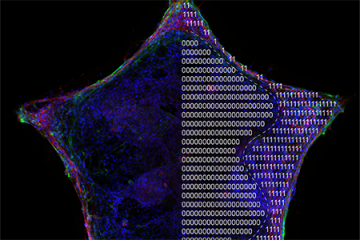The human body can withstand much greater loads than its sheer material strength would suggest. Sprinters can push an Achilles tendon to more than 75 percent of its tensile strength, while weightlifters lifting a heavy barbell can push themselves to over 90 percent of the spine's load capacity. Individual collagen fibers tear, and the body repairs them before the entire tendon breaks down. "The true biological system is adaptive," says Sean Sun, Whiting School of Engineering professor of mechanical and biomedical engineering. "If you lift weights, you build muscle. That process adapts to whatever load your body is experiencing."
What if buildings or bridges could be designed, constructed, and maintained like the human body, Sun wondered. "During a class discussion, it occurred to me that man-made engineering systems are typically 'you build it, it's done,'" he says. "That is dramatically different from your body, which is constantly eating away tissue and then building new tissue to replace it." Instead of overengineering bulky structures to be two or three times stronger than their breaking point, these biology-inspired designs could be made much lighter but with the ability to repair themselves, just like bones and tendons. Sun and applied mathematics graduate student Dan Popescu propose such an approach could be employed to build a supertall "space elevator" using new kinds of hybrid materials and a fleet of robots programmed for constant maintenance.
Hold on, a space elevator?
One of the big obstacles to exploring and commercializing outer space is the high cost of getting materials into orbit, with rockets starting at around $3,000 per kilogram. Engineers and physicists have been dreaming of a space elevator—which could cost-effectively and energy-efficiently lift supplies into low-Earth orbit on a giant cable—since the idea was first floated by 19th-century Russian physicist Konstantin Tsiolkovsky. One end of the elevator cable would extend from somewhere near the equator, while the other end would be in geosynchronous orbit roughly 60,000 miles into space. This location provides the greatest amount of centrifugal force to offset the pull of gravity.
Also see
A 2006 NASA report said the idea would become feasible once there are enough advances in stronger, lightweight materials. And in 2018, Japanese researchers launched a small test of cable tied between two small satellites from the International Space Station as a precursor to a pilot project.
How will this thing work?
A traditional bridge cable uses thousands of individual strands of wire braided together to form a single bundle that can withstand a heavy load. But Sun and Popescu calculated that steel would be too heavy to support its own weight.
The tethers for a space elevator need to be thinner and lighter, and therefore operate much closer to their breaking point—similar to how a tendon works. By using a combination of Kevlar and lightweight carbon nanotubes, "that's how we could get there," Sun says.
The first of several long tethers making up the space elevator's cable would be dropped from orbit down to the Earth's surface. Others would follow, running parallel to one another. Autonomous robots would shimmy up and down the length of the elevator to replace strands of the filaments on a regular basis, mimicking our body's ability to repair and replace its structures and cells. Sun and Popescu outlined their proposal in a paper on the open access website arXiv and in an article in the magazine Aeon. The two wrote that sensors and artificial intelligence software would model the entire tether mathematically so as to predict when, where, and how the fibers would break, adjusting the rate of maintenance and repair as needed.
Taller, better, faster, stronger
Sun presented his proposal at the 2018 International Space Elevator Conference. The experience, he says, has reinforced his belief that big breakthroughs in engineering—say, a 400-mile-long suspension bridge or the next generation of mega-skyscrapers—won't come from bigger, stronger materials but rather looking to nature. "Evolution has come up with lots of interesting solutions and has continuously provided us inspiration," he says.
Posted in Science+Technology









